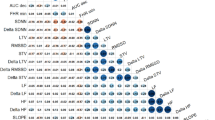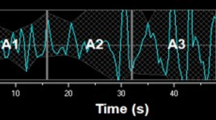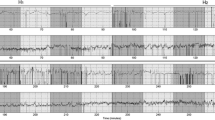Abstract
Fetal heart rate (FHR) monitoring is commonly used to predict asphyxia but clinical and experimental studies have questioned its diagnostic value. We examined the usefulness of fetal heart rate variability (fHRV) measures in detecting early asphyxia using chronically instrumented fetal sheep under normoxic (n = 6) and asphyxic conditions (3 umbilical cord occlusions, n = 6). The occlusions consistently led to pH decreases from 7.35 ± 0.01 to 7.09 ± 0.03 (V < .05). FHR showed biphasic deceleration during each occlusion, associated with increasing arterial blood pressure (V < .05). RMSSD, an index of vagal modulation of fHRV, increased consistently during repeated occlusion induced FHR decelerations (V < .05). Under normoxic conditions, RMSSD did not change during FHR decelerations and decreased during FHR accelerations (V < .05). Our results suggest that an increase of RMSSD in association with FHR decelerations reflects initial vagal activation during fetal asphyxia. RMSSD may accurately identify asphyxic fetuses early. Clinical validation is needed.
Similar content being viewed by others
References
MacDonald D. Cerebral palsy and intrapartum fetal monitoring. N Engl J Med. 1996;334:658–660.
Low JA. Determining the contribution of asphyxia to brain damage in the neonate. J Obstet Gynecol Res. 2004;30:276–286.
Oppenheimer LW, Lewinsky RM. Power spectral analysis of fetal heart rate. Baillieres Clin Obstet Gynaecol. 1994;8:643–661.
Kazandi M, Sendag F, Akercan F, Terek MC, Gundem G. Different types of variable decelerations and their effects to neonatal outcome. Singapore Med J. 2003;44:243–247.
Williams KP, Galerneau F. Comparison of intrapartum fetal heart rate tracings in patients with neonatal seizures vs. no seizures: what are the differences? J Perinat Med. 2004;32:422–425.
Freeman RK. Problems with intrapartum fetal heart rate monitoring interpretation and patient management. Obstet Gynecol. 2002;100:813–826.
Süra SM, Ojala TH, Vahlberg TJ, et al. Marked fetal acidosis and specific changes in power spectrum analysis of fetal heart rate variability recorded during the last hour of labour. Bjog. 2005;112:418–423.
George S, Gunn AJ, Westgate JA, Brabyn C, Guan J, Bennet L. Fetal heart rate variability and brain stem injury after asphyxia in preterm fetal sheep. Am J Physiol Regul Integr Comp Physiol. 2004;287:R925–R933.
Ikeda T, Murata Y, Quilligan EJ, et al. Fetal heart rate patterns in postasphyxiated fetal lambs with brain damage. Am J Obstet Gynecol. 1998;179:1329–1337.
Westgate JA, Bennet L, Gunn AJ. Fetal heart rate variability changes during brief repeated umbilical cord occlusion in near term fetal sheep. Br J Obstet Gynaecol. 1999;106:664–671.
Thacker S, Stroup D, Peterson H. Efficacy and safety of intrapartum electronic fetal monitoring: an update. Obstet Gynecol. 1995;86:613–620.
de Haan HH, Gunn AJ, Gluckman PD. Fetal heart rate changes do not reflect cardiovascular deterioration during brief repeated umbilical cord occlusions in near-term fetal lambs. Am J Obstet Gynecol. 1997;176(1 pt 1):8–17.
Parer JT. Electronic fetal heart rate monitoring: a story of survival. Obstet Gynecol Surv. 2003;58:561–563.
Electronic fetal heart rate monitoring. Research guidelines for interpretation. National Institute of Child Health and Human Development Research Planning Workshop. Am J Obstet Gynecol. 1997;177:1385–1390.
Malcus P. Antenatal fetal surveillance. Curr Opin Obstet Gynecol. 2004;16:123–128.
Heart rate variability. Standards of measurement, physiological interpretation and clinical use. Task Force of the European Society of Cardiology and the North American Society of Pacing and Electrophysiology. Circulation. 1996;93:1043–1065.
Muller T, Lohle M, Schubert H, et al. Developmental changes in cerebral autoregulatory capacity in the fetal sheep parietal cortex. J Physiol. 2002;539(pt 3):957–967.
Yu ZY, Lumbers ER. Measurement of baroreceptor-mediated effects on heart rate variability in fetal sheep. Pediatr Res. 2000;47:233–239.
Frasch MG, Muller T, Wicher C, et al. Fetal body weight and the development of the control of the cardiovascular system in fetal sheep. J Physiol. 2007;579(pt 3):893–907.
Groome LJ, Mooney DM, Bentz LS, Singh KP. Spectral analysis of heart rate variability during quiet sleep in normal human fetuses between 36 and 40 weeks of gestation. Early Hum Dev. 1994;38:1–9.
Troeger C, Schaub AF, Bemasconi P, Hosli I, Holzgreve W. Spectral analysis of fetal heart rate variability in fetuses with supraventricular extrasystoles. Fetal Diagn Ther. 2003;18:284–288.
Mallard EC, Williams CE, Johnston BM, Gunning MI, Davis S, Gluckman PD. Repeated episodes of umbilical cord occlusion in fetal sheep lead to preferential damage to the striatum and sensitize the heart to further insults. Pediatr Res. 1995;37:707–713.
Schwab M, Müller T, Loehle M, et al. Glucocorticoid (GC) induced maturation of cerebral autoregulation may explain the decreased incidence of intraventricular hemorrhage (IVH) and increased risk of periventricular leukomalacia (PVL). J Soc Gynecol Investig. 2004; 11(2 suppl):192A.
Yawno T, Yan EB, Walker DW, Hirst JJ. Inhibition of neurosteroid synthesis increases asphyxia-induced brain injury in the late gestation fetal sheep. Neuroscience. 2007;146:1726–1733.
Bartelds B, van Bel F, Teitel DF, Rudolph AM. Carotid, not aortic, chemoreceptors mediate the fetal cardiovascular response to acute hypoxemia in lambs. Pediatr Res. 1993;34:51–55.
Itskovitz J, LaGamma EF, Bristow J, Rudolph AM. Cardiovascular responses to hypoxemia in sinoaortic-denervated fetal sheep. Pediatr Res. 1991;30:381–385.
Boddy K, Dawes GS, Fisher R, Pinter S, Robinson JS. Foetal respiratory movements, electrocortical and cardiovascular responses to hypoxaemia and hypercapnia in sheep. J Physiol. 1974;243:599–618.
Giussani DA, Spencer JA, Moore PJ, Bennet L, Hanson MA. Afferent and efferent components of the cardiovascular reflex responses to acute hypoxia in term fetal sheep. J Physiol. 1993;461:431–449.
Groome LJ, Loizou PC, Holland SB, Smith LA, Hoff C. High vagal tone is associated with more efficient regulation of homeostasis in low-risk human fetuses. Dev Psychobiol. 1999;35:25–34.
Jensen A, Gamier Y, Berger R. Dynamics of fetal circulatory responses to hypoxia and asphyxia. Eur J Obstet Gynecol Reprod Biol. 1999;84:155–172.
Dawes G, Meir YJ, Mandruzzato GP. Computerized evaluation of fetal heart-rate patterns. J Perinat Med. 1994;22:491–499.
Zhuravlev YE, Rassi D, Mishin AA, Emery SJ. Dynamic analysis of beat-to-beat fetal heart rate variability recorded by SQUID magnetometer: quantification of sympatho-vagal balance. Early Hum Dev. 2002;66:1–10.
Karin J, Hirsch M, Akselrod S. An estimate of fetal autonomic state by spectral analysis of fetal heart rate fluctuations. Pediatr Res. 1993;34:134–138.
David M, Hirsch M, Karin J, Toledo E, Akselrod S. An estimate of fetal autonomic state by time-frequency analysis of fetal heart rate variability. J Appl Physiol. 2007;102:1057–1064.
Blad S, Welin AK, Kjellmer I, Rosen KG, Mallard C. ECG and heart rate variability changes in preterm and near-term fetal lamb following LPS exposure. Reprod Sci. 2008;15(6):572–583.
Ross MG, Devoe LD, Rosen KG. ST-segment analysis of the fetal electrocardiogram improves fetal heart rate tracing interpretation and clinical decision making. J Matern Fetal Neonatal Med. 2004;15:181–185.
Rosen KG, Hokegard KH, Kjellmer I. A study of the relationship between the electrocardiogram and hemodynamics in the fetal lamb during asphyxia. Acta Physiol Scand. 1976;98:275–284.
Author information
Authors and Affiliations
Corresponding author
Rights and permissions
About this article
Cite this article
Frasch, M.G., Müller, T., Weiss, C. et al. Heart Rate Variability Analysis Allows Early Asphyxia Detection in Ovine Fetus. Reprod. Sci. 16, 509–517 (2009). https://doi.org/10.1177/1933719108327597
Published:
Issue Date:
DOI: https://doi.org/10.1177/1933719108327597




